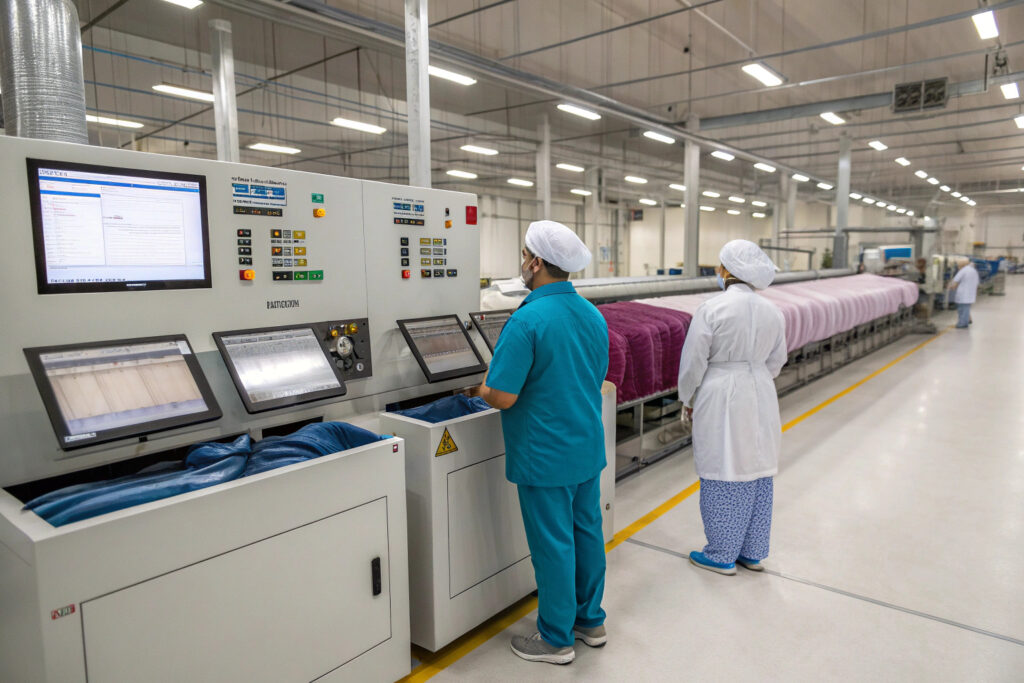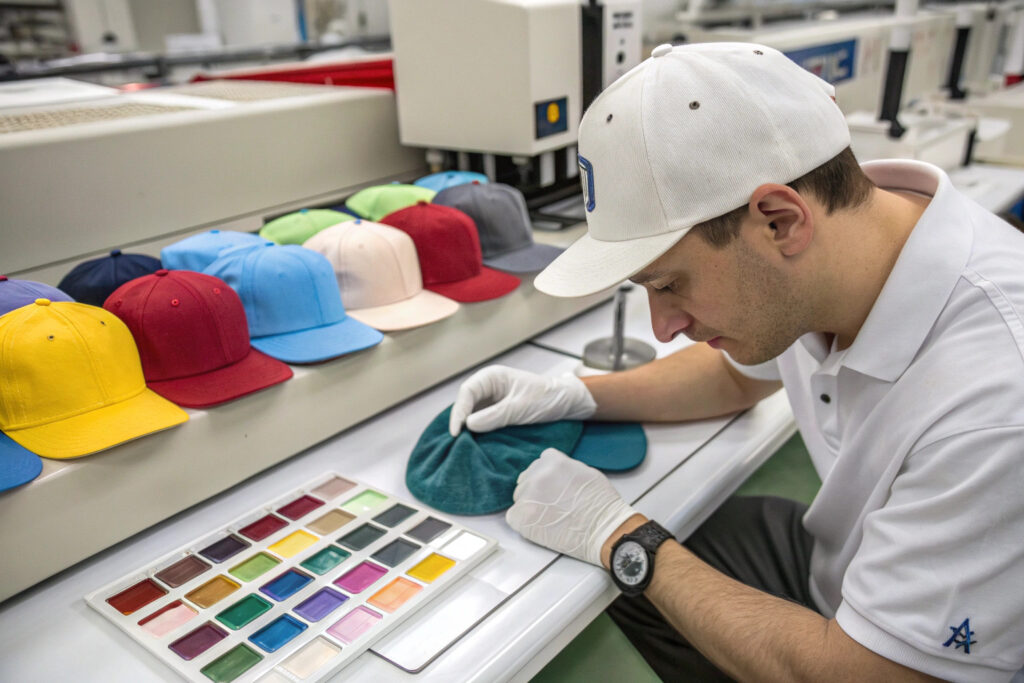Color bleeding in custom dyed caps can ruin your entire production run and damage your brand's reputation. Nothing disappoints customers more than receiving caps where colors have run together, creating muddy, unprofessional appearances. This common manufacturing problem often appears only after washing, when it's too late to fix the issue.
The most effective way to avoid color bleeding in custom dyed caps is through proper fabric selection, controlled dyeing processes, and rigorous colorfastness testing before production. By implementing strict quality control measures and using appropriate dye fixation techniques, manufacturers can ensure colors remain vibrant and separate throughout the cap's lifespan.
Understanding the science behind color bleeding and implementing preventive measures at each production stage can save you from costly returns and disappointed customers.
What Causes Color Bleeding in Dyed Caps?
Understanding the root causes of color bleeding is the first step toward prevention. The phenomenon occurs when dyes don't properly bond with fabric fibers and subsequently release during washing or exposure to moisture.
Color bleeding happens due to improper dye fixation, inadequate washing after dyeing, poor fabric-dye compatibility, or incorrect dyeing parameters. These factors allow excess dye to remain in the fabric rather than forming permanent bonds with fibers.

How Does Fabric Composition Affect Color Retention?
Different fabrics have varying capacities to absorb and retain dyes based on their fiber composition and surface characteristics. Choosing the wrong fabric-dye combination virtually guarantees color bleeding problems.
Natural fibers like cotton and wool have excellent dye affinity but require specific dye types and fixation processes. Synthetic fibers like polyester need disperse dyes applied at high temperatures for proper penetration. Our fiber identification testing ensures we match dyes to fabric composition. For cotton caps, we use reactive dyes that form covalent bonds with cellulose fibers, creating permanent color that resists bleeding. For blended fabrics, we conduct compatibility tests to ensure uniform dye uptake across different fiber types.
What Role Does Dye Fixation Play in Color Fastness?
Dye fixation is the chemical process that makes dyes permanent on fabrics. Inadequate fixation leaves excess dye molecules loosely attached to fibers, ready to bleed at the first exposure to moisture or friction.
Proper fixation involves both chemical and physical processes. We use industrial steam fixation for reactive dyes, which creates permanent bonds between dye molecules and fabric fibers. For synthetic fabrics, thermosol dyeing ensures dye penetration at molecular level. Our fixation processes include controlled temperature, humidity, and timing parameters verified through colorfastness testing to ensure no residual dye remains to cause bleeding issues in finished caps.
How to Select the Right Dyes and Fabrics?
Choosing appropriate materials is the foundation of color-fast cap production. The combination of fabric type and dye chemistry determines whether colors will remain vibrant and separate or bleed together.
The right dye-fabric combination depends on the cap's intended use, washing requirements, and color complexity. Professional manufacturers test multiple combinations before production to ensure optimal results.

Which Dye Types Offer Maximum Color Fastness?
Different dye classes offer varying levels of color fastness based on their chemical structure and bonding mechanisms. Selecting the appropriate dye type for your specific fabric is crucial for preventing color bleeding.
We categorize dyes by their performance characteristics:
- Reactive dyes: Form covalent bonds with cellulose fibers (cotton, linen)
- Disperse dyes: Penetrate synthetic fibers through high-temperature application
- Acid dyes: Work with protein fibers (wool, silk) through ionic bonding
- Pigment dyes: Sit on fabric surface, requiring proper fixation
Our dye selection process involves testing multiple dye types against specific fabrics to determine which combination provides the highest colorfastness to washing. For most custom caps, we recommend reactive dyes for natural fibers and disperse dyes for synthetics, as these provide the most permanent color solutions.
How Does Fabric Preparation Impact Dye Absorption?
Proper fabric preparation before dyeing significantly affects how evenly and permanently dyes absorb into fibers. Inadequate preparation leads to uneven dyeing and increased bleeding risk.
Our fabric preparation process includes:
- Desizing: Removing manufacturing starches and lubricants
- Scouring: Cleaning fibers to remove natural waxes and impurities
- Bleaching: Creating uniform white base for accurate color reproduction
- Mercerizing: Strengthening cotton fibers and improving dye affinity
We follow AATCC preparation standards to ensure consistent results. Proper preparation creates clean, receptive fibers that absorb dyes evenly and retain them effectively during washing, significantly reducing bleeding risks in finished caps.
What Production Processes Prevent Color Bleeding?
Beyond material selection, specific manufacturing processes and quality control measures are essential for preventing color bleeding. These processes ensure dyes remain fixed and colors stay separate throughout the cap's life.
Color bleeding prevention requires controlled dyeing parameters, proper washing after dyeing, and effective fixation methods. Each step must be carefully monitored and validated.

How Important is Post-Dyeing Washing?
Thorough washing after dyeing is critical for removing unfixed dye that would otherwise bleed during later washing by consumers. Inadequate rinsing is a common cause of color bleeding in finished products.
Our post-dyeing washing process includes multiple stages:
- Initial rinse: Removes excess surface dye
- Soaping: Uses specialized detergents to remove unfixed dye molecules
- Multiple rinses: Ensures complete removal of all loose dye
- pH balancing: Neutralizes fabric to prevent future color migration
We verify washing effectiveness through spectrophotometer testing of rinse water until no dye residue is detected. This thorough removal process ensures only permanently fixed dye remains in the fabric, eliminating bleeding risks in the final product.
What Quality Control Tests Prevent Color Bleeding?
Comprehensive quality control testing identifies potential bleeding issues before caps reach customers. These tests simulate real-world conditions to verify color fastness.
Our quality control protocol includes:
- AATCC 61 Colorfastness to Washing: Simulates multiple home launderings
- ISO 105-E03 Colorfastness to Water: Tests bleeding in wet conditions
- Crocking tests: Verifies color doesn't transfer through friction
- Perspiration tests: Ensures color stability against body acids
We maintain a CNAS-certified laboratory that conducts these tests on every dye lot before production approval. Any batch failing these tests is rejected or re-processed to ensure only color-fast caps enter production.
How to Specify Color Fastness Requirements?
Clear communication of color fastness requirements ensures manufacturers understand your quality expectations and can implement appropriate processes to meet them.
Proper specification involves defining testing standards, acceptable performance levels, and verification methods. These specifications become part of your quality agreement with manufacturers.

What Industry Standards Define Color Fastness?
Several international standards define color fastness testing methods and performance criteria. Understanding these standards helps you specify appropriate requirements for your custom caps.
Key industry standards include:
- AATCC 61: Colorfastness to Laundering, Home and Commercial
- ISO 105-C06: Colorfastness to Domestic and Commercial Laundering
- AATCC 8: Colorfastness to Crocking
- ISO 105-E04: Colorfastness to Perspiration
We recommend specifying AATCC 61 2A for most custom caps, which simulates five home launderings with a minimum grade of 4 for color change and staining. Higher specifications may be needed for caps requiring frequent washing or exposure to harsh conditions.
How to Communicate Color Requirements to Manufacturers?
Clear technical communication prevents misunderstandings about color performance expectations. Detailed specifications help manufacturers allocate appropriate resources and processes.
Our technical package template includes:
- Color standards: Pantone references with acceptable delta-E tolerances
- Testing requirements: Specific standards and minimum performance grades
- Sample approval process: Pre-production and production sample testing
- Documentation requirements: Test reports for each production lot
We provide clients with digital color standards and specific testing protocols to ensure consistent understanding of color fastness expectations before production begins.
Conclusion
Preventing color bleeding in custom dyed caps requires a comprehensive approach involving proper material selection, controlled dyeing processes, thorough washing, and rigorous testing. By understanding the causes of color bleeding and implementing preventive measures at each production stage, you can ensure your caps maintain their vibrant, separate colors throughout their lifespan.
Working with manufacturers who prioritize color fastness testing and maintain strict quality control protocols is essential for delivering products that meet customer expectations and protect your brand reputation.
Ready to produce custom dyed caps with guaranteed color fastness? Contact our Business Director Elaine today to discuss our color management systems and testing capabilities. Her email is elaine@fumaoclothing.com. Let's create vibrant, color-fast caps that maintain their professional appearance wash after wash.







